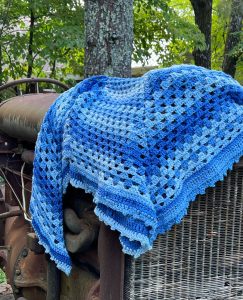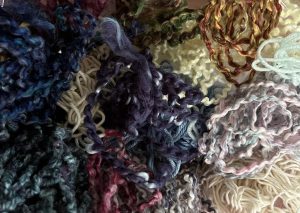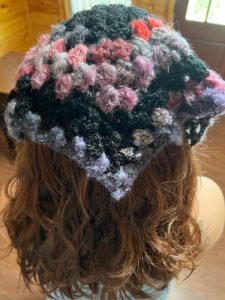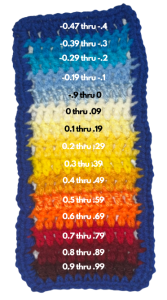 Disclaimer: In my ten or so years of knitting and crocheting (mostly knitting, although these pictures are of recent crochet projects), I have not intentionally thought about the sustainability of these crafts until moving into the Greenbelt. By no means am I an expert, but I am slowly making adjustments in my practices. Most of the pictures I have included are crafted from acrylic yarn, although it was purchased from thrift stores or donated to me and I hope to improve this in the future.
Disclaimer: In my ten or so years of knitting and crocheting (mostly knitting, although these pictures are of recent crochet projects), I have not intentionally thought about the sustainability of these crafts until moving into the Greenbelt. By no means am I an expert, but I am slowly making adjustments in my practices. Most of the pictures I have included are crafted from acrylic yarn, although it was purchased from thrift stores or donated to me and I hope to improve this in the future.
Knitting itself is rather sustainable because it is a way to opt out of the unsustainable system of fast fashion. Fast fashion is a term that applies to cheaply manufactured clothing imitations of current—fleeting—fashion trends (Joy et al.). A quick Google search of the advantages and disadvantages of fast fashion raises concerns over water use, chemical pollution, CO2 emissions and textile waste (Niinimäki et al.).
By knitting, you can circumvent the frequently sub-par labor policies of fast fashion companies. Among the plethora of issues with the labor force in the fast fashion industry is child labor. Globally, an estimated 170 million children are somehow involved in fast fashion’s labor force (Buzzo and Abreu).
Another advantage of knitting is that it often allows us to decrease our environmental footprints by infrequently hand washing and line drying projects. This minimizes our water and electricity usage and the release of microplastic and/or fiber fragments into the water system and eventually the environment during washing, drying, and wearing (Periyasamy and Ali).
Aside from the built-in sustainable aspects of knitting, there are a variety of choices we can make to make our craft more sustainable. Be kind to the environment and choose a few of these ideas which easily mesh with your knitting styles to begin incorporating into your daily life. And remember, individual sustainability is all about finding green practices that can realistically fit into your routines, so be kind to yourself!
1 Source your knitting needles from thrift shops. If you cannot find what you are looking for there, then opt for metal or bamboo knitting needles, which last longer than plastic options. If you do not already have a set of circular knitting needles, consider investing in an interchangeable needle set. They can be quite pricey, but are an investment that means you will use less resources.
 2 Use the yarn you already have in your stash before purchasing more. Frog* the WIP** that has been sitting on your shelf for the past few months and repurpose the yarn. If you have an outdated blanket you no longer use, frog it too. If—like all good little knitters—you do gauge swatches***, reuse the yarn. When you finish a project, save those yarn scraps for a beautiful scrap blanket or other mix-and-match, scrap-friendly projects. I cannot wait until I have enough scraps for a blanket!
2 Use the yarn you already have in your stash before purchasing more. Frog* the WIP** that has been sitting on your shelf for the past few months and repurpose the yarn. If you have an outdated blanket you no longer use, frog it too. If—like all good little knitters—you do gauge swatches***, reuse the yarn. When you finish a project, save those yarn scraps for a beautiful scrap blanket or other mix-and-match, scrap-friendly projects. I cannot wait until I have enough scraps for a blanket!
3 Head to the thrift store to get some yarn on the dime while giving new life to something that might otherwise go to a landfill. In addition to finding second-hand skeins of perfectly usable yarn, you can frog thrifted sweaters to repurpose the yarn. Read about how this practice can become a side hustle here. You can also easily upcycle old t-shirts, bed sheets, and plastic grocery bags into yarn as well, although these will not work for all projects. If nothing else, swap yarn you do not plan on using with fellow knitters or arrange community yarn exchanges.
4 If a project requires first-hand yarn, then research the advantages and disadvantages of yarn fibers first. Eco-Stylist’s A Guide to the Most and Least Sustainable Fabrics is a helpful starting place. It can be difficult to get to the true ecological footprint of yarns because there is not a hard and fast rule. After choosing a sustainable yarn fiber that will suit the needs of your project, research the practices of the company before making a purchase. Explore EcoCult’s The Best Sustainable and Ethical Knitting Yarns For Your Next Project for a brief overview of reputable yarn sources. Remember, organic does not always mean environmentally-friendly or ethical; be skeptical of greenwashing. If you can afford to, then buy locally and participate in the slow yarn movement. Slow yarn is any yarn that has been handmade, hand dyed, or in some way embellished by a real person rather than a factory machine.
 5 Look for opportunities to replace disposable products with knitted alternatives. For example, Swiffer covers, shower scrubbies, shopping bags, and gift wrapping can all be easily knitted to minimize resource waste. Spend a few hours scrolling through Pinterest for inspiration or swap ideas with your local knitting community. I hope to begin phasing out disposable products and replacing them with knitted alternatives during my time here in the Greenbelt and beyond to life after Furman.
5 Look for opportunities to replace disposable products with knitted alternatives. For example, Swiffer covers, shower scrubbies, shopping bags, and gift wrapping can all be easily knitted to minimize resource waste. Spend a few hours scrolling through Pinterest for inspiration or swap ideas with your local knitting community. I hope to begin phasing out disposable products and replacing them with knitted alternatives during my time here in the Greenbelt and beyond to life after Furman.
6 Gift, donate, raffle, or sell finished objects that you do not use. Like all knitters, I am guilty of keeping far too many “love it too much to part ways” projects lying around. While living in the Greenbelt, I hope to make progress in this area by experimenting and embracing a zero-waste business model as much as possible.
This is by no means an extensive list, but hopefully gets those creative juices flowing on how we can tweak our knitting habits to become more sustainable and encourage our fellow knitters to reflect on their practices as well.
For those unfamiliar with knitting terminology:
*Frog- Ripping out a project.
**WIP- Work in progress.
***Gauge swatch- A square piece of knitting completed before beginning a project that is meant to standardize the size of the finished product since knitting tensions, needles, and yarn interact uniquely.
Works Cited
“The Best Sustainable and Ethical Knitting Yarns for Your Next Project.” EcoCult, 6 Dec. 2021, https://ecocult.com/the-best-sustainable-and-ethical-knitting-yarns-for-your-next-project/.
Buzzo, Aline, and Maria José Abreu. “Fast Fashion versus Fair Trade and Labor Practices.” Fast Fashion, Fashion Brands and Sustainable Consumption, Springer, Singapore, 2019, https://doi.org/10.1007/978-981-13-1268-7_1. Accessed 16 Sept. 2022.
Gray, Kaitlyn. “A Guide to the Most and Least Sustainable Fabrics.” Eco-Stylist, 4 June 2022, https://www.eco-stylist.com/a-guide-to-the-most-and-least-sustainable-fabrics/.
Joy, Annamma, et al. “Fast Fashion, Sustainability, and the Ethical Appeal of Luxury Brands.” Fashion Theory, vol. 16, no. 3, 21 Apr. 2012, pp. 273–295., https://doi.org/10.2752/175174112×13340749707123. Accessed 16 Sept. 2022.
Justus, Evan. Blue Granny Square Blanket on Tractor. Accessed 16 Sept. 2022.
Justus, Evan. Scrap Yarn Collection. Accessed 16 Sept. 2022.
Justus, Kara and Carter Carter. Multicolor Granny Square Bandana. Accessed 16 Sept. 2022.
Niinimäki, Kirsi, et al. “The Environmental Price of Fast Fashion.” Nature Reviews: Earth and Environment, vol. 1, no. 4, 7 Apr. 2020, pp. 189–200., https://doi.org/10.1038/s43017-020-0039-9.
Periyasamy, Aravin Prince, and Ali Tehrani-Bagha. “A Review on Microplastic Emission from Textile Materials and Its Reduction Techniques.” Polymer Degradation and Stability, vol. 199, May 2022, https://doi.org/10.1016/j.polymdegradstab.2022.109901.
Singh, Rupa. “Sustainability Side Hustle: Q+A with Recycled Yarn.” Honestly Modern, 24 July 2022, https://www.honestlymodern.com/sustainability-side-hustle-recycled-yarn/.
 Artist Statement
Artist Statement


 5
5